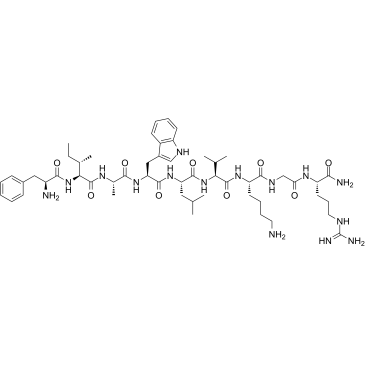1225021-13-5
| Name | GLP-1 (28-36)amide |
|---|
| Description | GLP-1(28-36)amide, a C-terminal nonapeptide of GLP-1, is a major product derived from the cleavage of GLP-1 by the neutral endopeptidase (NEP). GLP-1(28-36)amide is an antioxidant and targets to mitochondrion, inhibits mitochondrial permeability transition (MPT). GLP-1(28-36)amide has anti-diabetic and cardioprotection effects[1]. |
|---|---|
| Related Catalog | |
| In Vitro | Different from DPP-IV, NEP, which cleaves GLP-1(7-36)amide or GLP-1(9-36)amide to generate GLP-1(28-36)amide, is widely distributed in endothelial cells, vascular smooth muscle cells, cardiac cells and renal epithelial cells[1]. GLP-1(28-36)amide (100 nM) treatment on hepatocytes for 24 hours directly modulates mitochondrial oxidative metabolism, such as gluconeogenesis in mitochondria of hepatocytes[1]. The plasma half-life of GLP-1(28-36)amide is longer in human hepatocytes (t1/2 = 24 min) than that in mouse hepatocytes (t1/2 = 13 min)[1]. |
| In Vivo | The administration of GLP-1(28-36)amide at a rate of 18.5 nmol/kg BW/day for 9 weeks to diet-induced obese mice diminishes the development of hepatic steatosis[1]. The intraperitoneal injection of 18 nmol/kg GLP-1(28-36)amide once daily for 9 weeks show cytoprotective effect on pancreatic β cells by increasing mass and promoting proliferation in a β-cell injury diabetic mouse model[1]. An in vivo study in high-fat diet-fed mice indicates that a six-week administration of 18.5 nmol/kg GLP-1(28-36)amide improved hepatic glucose disposal, which is associated with increased cAMP levels and phosphorylation of PKA target[1]. Administered GLP-1(28-36)amide for 20 min to male C57BL6/J mice (10-12 week old), then isolated hearts underwent 30 min of global ischemia and 40 min of reperfusion, the recovery of left ventricular developed pressure (LVDP) is significantly greater in GLP-1(28-36)amide group compared to vehicle-treated hearts[1]. |
| References |
| No Any Chemical & Physical Properties |
